Chapter Two
Part Two
| Moving ahead now to 1907 in which
year the motor industry suffered its first slump. It can be
noted that Sunbeam weathered the storm much better than many
others. Frederick Eastmead entered a reliability trial in
Ireland with a 16/20 and completed the event without loss of
marks. |
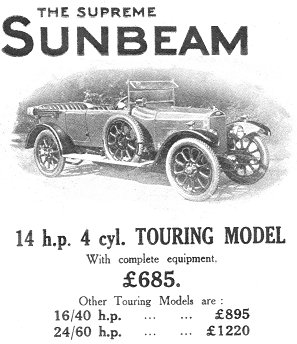 |
For some years Sunbeam
cars had been fitted with Loyal multi tube radiators but from
1906 Marston ‘honeycombe’ radiators made under Megevets patents
were used and these would become one of the company’s major
products and continue in production long after vehicle
manufacture had ceased.
Though his 16/20 was
proving a success and bringing some fame to the
Wolverhampton firm Angus Shaw was hard at work on his next
project, a six cylinder engine with the same cylinder
dimensions as the four, with separately cast cylinders. The
chassis was made of ash, reinforced with steel girder
plates, having a wheelbase of 10' 4" and a track of 4' 4". |
|
Listed at £750 for the
chassis and £50 for a touring body, the Sunbeam appeared to be a
bit expensive and did not prove to be a success, soon being
withdrawn. Modifications were made to the 16/20 with the bore
and stroke being increased to 105 x 130mm giving the engine more
reserves of power for hill climbing, which was never a strong
feature on the earlier Sunbeams. This model became known as the
Twenty.
Shaw also designed a 120
x l40mm four cylinder 35h.p. car, priced at £675. There was
still some resistance at this sort of price and few were sold.
Some significant changes were about to take place at Sunbeam
when a famous French engineer joined the company. That story we
must leave until later. |
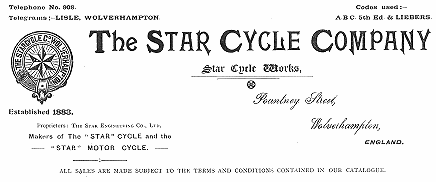
| During the period under review Star
had expanded and continued to grow. In 1905 they could offer
a comprehensive range of cars which included a twin cylinder
7h.p. model listed at £175, a four cylinder car at £260 as
well as several other models of up to 30h.p.
About this time there was a decline in
pedal cycle sales. Star were very large producers of these
machines so for 1905 the Star Cycle Company run by Edward
Lisle junior introduced the Starling, a cheap light car for
sale through their cycle agents. It had a single cylinder De
Dion like engine, two speed gear and chain drive, selling
for a modest £110. The following year a twin cylinder model
was brought out with three speeds and a shaft drive. Known
as the ‘Stuart’ these cheaper Stars continued until 1908
when the Stuart name was dropped and all the Star Cycle
Company cars became Starlings. |
|
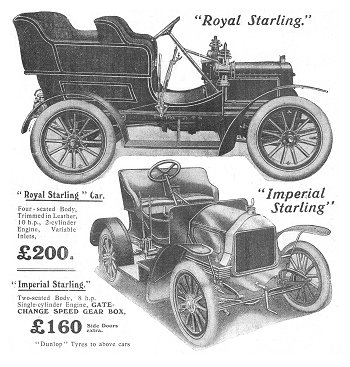
An advert from 1908. |
At the 1907 Cordingley
Show the Royal Starling had been shown and created a lot of
interest, being very much on the lines of the larger Stars.
Its twin cylinder engine had cylinder dimensions of 3.75" x
4.5", three speed gear, and a leather faced cone clutch. The
engine speed was controlled by variable lift inlet valves
operated by a wedge that could be slid in or out between
cams and valve tappets. Also exhibited were two Starlings
which were proving popular in view of their low price,
though this had now been upped to £120.
During 1909 the Starlings and Royal Starlings were dropped
and a new company, the Briton Motor Company was formed with
Edward Lisle junior in charge. Their policy was to produce
good quality light cars at a reasonable price. |
|
The cheaper Star models
would now be Britons and the 10h.p. twin cylinder car became
popular and sold in good numbers, but a 4 cylinder 10h.p. model
did not prove successful sales wise. At the A.G.M. of the Star
Cycle Company held at the Star & Garter Hotel on 29th January,
1909 the name was changed to the Star Engineering Company.
Star Engineering also
had a stand at the 1907 Cordingley Show and displayed their
first six cylinder car, a 30hp model with cylinder dimensions of
4.25" x 5", cast in pairs. Other features included a special
automatic carburettor, magneto ignition, and automatic oiling.
The three speed gearbox had direct drive on top.
Also on show was the
7h.p. that had been updated, a honeycomb radiator now replaced
the earlier gilled tube affair and the tubular front axle had
given way to one of ‘H’ section stamped steel. Star also proudly
displayed parts of a car they had supplied in February 1906 to
the Royal Automobile Club for use in teaching members and their
servants to drive. Over the following year the car ran l0,000
miles and something like 550 lessons were given. Quite an
arduous life, yet the cost of repairs and replacements during
that time were reported as nil.
The following month it
was considered expedient to dismantle the car for inspection.
Only very slight wear was found in the gears and only one big
end needed attention. Chains and chain wheels were also seen to
be in excellent shape and like the clutch good for many more
miles.
All this a wonderful
testimony to the fine workmanship and materials used in Star
cars, and the company made extensive use of it in their
advertisements. Much the centre of attraction on the Star stand
was a T.T. type l8h.p. car with side entrance Phaeton bodywork.
It was powered by a 4 cylinder engine with cylinders of 4.25" x
5" and included magneto ignition, and a four speed gearbox with
direct drive on top. |
|
This model was based on
cars entered in that years RAC Tourist Trophy races, a race Star
contested three times, unfortunately each time without success.
It would perhaps now be opportune to consider some of Star's
competition efforts. Edward Lisle had not at all been put off by
the lack of success of his car built for the 1903 Gordon Bennett
race and decided to try again in 1905. The 1904 race had been
won by Richard Thery driving a French Richard Brasier. The best
performance by a Briton had been Sidney Girling's 9th place on a
Wolseley. Charles Jarrott on a similar car claiming 12th place.
Two Stars were prepared
for the 1905 eliminating trials which were to be held in the
Isle of Man and would take the form of a race of about 300 miles
over the mountain circuit. Also taking part would be four
Napiers, two Wolseleys a Siddley and a Wier Darraque.
|
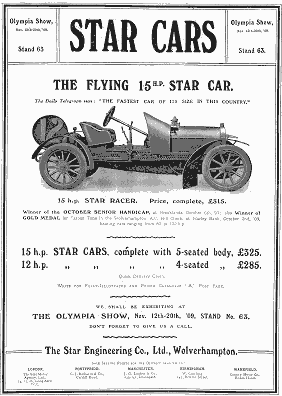
An advert from 1909. |
|
Star suffered an early
misfortune when Joe Lisle had been involved in an accident on
Tettenhall Road, Wolverhampton whilst testing one of the race
cars. He was heavily fined and disqualified from driving. Due to
this the organising club would not permit him to drive in the
trials. Edward Lisle then engaged two brothers H. and F.
Goodwin. Both were Star cycle agents and whilst they were well
known as first class cycle racers they were complete novices
when it came to motor racing. It is said that one had to be
taught to drive before he could enter the trials. The cars were
very much like contemporary Mercedes with four cylinders cast in
pairs and dimensions of 139.7 x 165.1mm. They developed 90b.h.p.
and had a four speed gearbox with a Hele Shaw spiral spring
clutch and final drive by side chains. In its report 'Autocar'
said they were splendid machines, fine examples of engineering
and with almost every part made in the Wolverhampton works.
In the eliminating
trials Napiers were the cars to beat. Over the flying half-mile
Arthur Macdonald recorded 88.2m.p.h. and F. Goodwin could only
manage 50m.p.h. on his Star. Unfortunately his brother had a lot
of problems with leaking water jackets on his car. In the
eliminating race only two cars completed the 300 miles; Clifford
Earp's Napier and the Wolseley driven by Cecil Bianchi. H.
Goodwin had managed to complete five of the six laps and was up
to 6th place when forced out with mechanical trouble. F. Goodwin
had also been in 6th spot at one time but fell out after three
laps, including the fastest lap by a Star at 38.6m.p.h. The
fastest lap of the day had fallen to Cecil Edge on a Napier with
a speed of 56m.p.h.
The team chosen to
represent England in the 1905 Gordon Bennett race were Earp
on a Napier, Rolls and Bianchi on Wolseleys, and Cecil Edge
and John Hargreaves on Napiers. In the race Theray again won
for France on his Richard Brasier. Rolls proved to be best
of the British team bringing his Wolseley into 8th place
with Earp next and Bianchi 11th. This would prove to be the
last Gordon Bennett race for cars, the following year it
would be for balloons and from 1909 for aeroplanes.
|
|
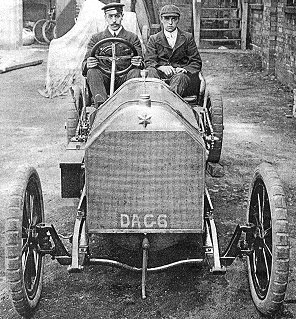
Harry Goodwin's 70h.p. Star racer from
1905. |
Earlier reference was
made to the RAC Tourist Trophy races. These were to become very
famous events that were first held in 1905 in the Isle of Man.
The course was very similar to the one used from 1911 to the
present day for the Auto Cycle Unions Tourist Trophy motorcycle
races. Although Wolverhampton cars would perform well in the
former they would not enjoy the great successes of the
Wolverhampton motor cycle factories in later years. Two modified
Star touring cars were entered for the 1906 T.T. but both
retired about 50 miles from the finish when they ran out of
petrol. They had not been well placed during the race.
The race was won by Hon. Charles Rolls driving a Rolls Royce at
an average speed of 39.43m.p.h. for the 161 miles. Despite this
poor showing Star were back again for the 1906 race with two
cars. |
|
They were four cylinder
102 x 127mm with an RAC rating of 25.5h.p. Reports referred to
them as rather pretty cars. In the race Prew crashed at Quater
Bridge through unsuitable tyres for the very wet conditions
under which the race was run. The other Star was also forced to
retire. Though the Wolverhampton cars had not shown up well,
people who had been or would be connected with the towns
industry did quite well. Thomas Pullinger late of Sunbeam
finished 5th driving a Beeston Humber of which he was designer.
Louis Coatalen, who we have yet to meet as Chief Engineer at
Sunbeam was 6th on a Coventry Humber, and Algernon Lee Guiness
who with his brother Kenelm would be famous as racing drivers of
Sunbeam cars took 3rd spot in a Darraque.
Before leaving Star for
the time being it is well to note that Mr. Edward Lisle founder
and Managing Director was a highly respected figure in both the
cycle and motor trades. Mr. Lisle was a very straight forward
and astute business man, so that when cycle sales fell he
entered into car manufacture and did quite well. Also later he
introduced cheap cars for his agents to sell, again with marked
success. When it had been decided to produce the extra products
Mr. Lisle did not reform the company and did not ask his
shareholders for more cash, putting up considerable sums of his
own money to carry the firm over the difficult period. That this
paid off is shown in reports in the motoring and cycle trades
press, they could report profits in the order of £10,000 in 1910
with every chance of these being doubled in the very near
future. |
 |
 |
 |
Return to
Part 1 |
Return to
the beginning |
Proceed to
Part 3 |
|